Windows 8 and the Microsoft Surface
Right now, people are burying Windows 8. Even people you'd normally expect to be on Microsoft's side are unhappy with it. Me, though? I kind of like it.
When Apple originally brought out the first iPad, I bought one as soon as I could. I always liked touchscreen devices. Long before1 Steve Jobs held the first iPhone prototype in his hands, I carried a button-less, touchscreen-only SonyEricsson P800.
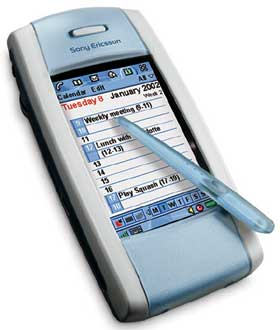
Heck, I owned various Newtons,2 and used them to take notes in school. So the iPad really made sense to me.
The Problem that Surface Solves (For Me)
When Jobs introduced the iPad, he wanted it to be seen as a productivity device. He had Phil Schiller demo Keynote, Numbers, and Pages.
I used the Newton as a productivity device. I used the P800 as a productivity device. But at least for me, the iPad never turned out to be a good productivity device. It turned out to be great for browsing the web, watching movies, and playing games. Great for reading books and comics. Great for consumption. But not great for production.
To be sure, it's absolutely possible to use iPads productively.3 In fact, Apple blogs love to point to examples of people who do use iPads to produce things. And yes, these people exist. There are artists who draw on iPads, and musicians who make music on iPads, and writers who write novels on iPads, and movie makers who cut their movies on iPads. But the fact that you have to point to these people, the fact that there are articles about these people, shows that they're unusual. An artist drawing a painting on an iPad is a novelty.
If it was normal for people to use their iPads for creative tasks, there would not be newspaper articles about people using their iPads for creative tasks. The iPad will have arrived as a productivity device when news sites stop reporting about people who use iPads for productivity. So in the end, all of these links to articles about people who use their iPads to create things only seem to support the notion that this is not how most people use their iPads.
Responding to people who note that the iPad seems to be mostly used for content consumption, John Gruber writes: "for these people, the iPad is unsuitable for content creation for anyone unless it’s suitable for them," implying that there's something special about people who don't use iPads productively. But I don't think that's fair. On the contrary, I think it's somewhat unusual to find iPad owners who do use their iPads for content creation on a regular basis. Even when you just look at very basic creative tasks — say, responding to email, rather than just reading email — most people seem to prefer PCs overs iPads.
It's not an accident that the best selling, highest grossing iPad apps are almost exclusively games.4
Some people point out that most PC users don't use their PCs to make music, and paint pictures, either. That's true. But they do use their PCs to write letters, presentations, invitations, create birthday cards, or send emails. And while you can use your iPad for these things — and I know that there are people who do — it's often easier to do it on a PC. The same things that make iPads easy to use for some things can make them harder to use for others.
Consider a creative task that almost everybody has to do: writing a job application.
When you write your cover letter, you might want to also look at the job ad on the Internet, so you can tailor your letter to the job. On an iPad, you can't see your letter and the job ad at the same time.
You might want to send your letter to a friend to read. Maybe that friend will send back some suggestions. On an iPad, you can't see the email with the suggestions and your letter at the same time.
Your CV probably includes a picture. Maybe you went to a photographer who gave you a CD with copies of the pictures she took. You can't easily copy them to your iPad. Once there, you probably want to touch them up a bit, and crop them. It might be inconvenient to move the image file between all of the apps you'll use to work on it.
Finally, you might want to export your letter and CV as PDFs, maybe combine them into a single PDF, or maybe ZIP them. You want to attach the resulting file to an email. It's reasonably simple on a Mac or PC, but I'm not sure if some of these things are even possible on an iPad.
Apple has decided to make the iPad as simple as possible, but sometimes, this simplicity comes at the expense of power. Not having any kind of window management or split-screen view makes the iPad much easier to use, but it also means you can't look at an email and at a Pages document at the same time. Preventing apps from interacting with each other cuts down on complexity, but it also means that it is difficult or sometimes even impossible to use multiple apps in conjunction on the same task. Not having any kind of system-level concept of a file or a document means that people are less likely to lose track of their files or documents,5 but it also means that you are often very limited in what you can do with the things you create in an iPad app.
As Joanna Stern puts it, "if I'm writing long emails or working on office documents, I want a larger screen, a roomy keyboard and the ability to easily juggle programs."
Fraser Speirs, whom nobody will suspect of being against using iPads in productive settings, points out that Apple seems to be stagnating in this area:
I still think it's a fair question to ask after the relative functional (if not visual) stasis of iOS 6 and iOS 7: where does iOS go from here?
At the launch of iOS 5, Scott Forstall said that Apple had undertaken an exercise to identify and remove all the missing functionality in iOS that caused people to go back to a computer. The examples he gave were creating new calendars and mailboxes. Perhaps it's time to do that exercise again.
And that's the problem I'm trying to solve. I acknowledge that there are people for whom the iPad works well as a productivity device. For me personally, though, that was never the case (and I don't think I'm alone in this). But I do want to use a tablet as a productivity device. Fraser Speirs is asking Apple to make iOS a better platform for these kinds of tasks, but I'm not waiting anymore. I want to use a tablet that has an elegant user interface, but also works well for productivity.
A few months ago, I gave away my iPad,6 and replaced it with, of all things, a Microsoft Surface Pro 2.
What I Like
Almost everything that happens inside the Metro7 environment is fantastic. It's clean, fast, and powerful. The apps are easy to use, but still offer a lot. The gesture-based user interface requires you to learn8 a few new things, but takes very little time to get used to.
The spatial way that apps are arranged on the home screen is great. It's very easy to group apps, name groups, rearrange apps or groups, zoom out to see an overview of all of your apps, change the size of individual apps to emphasize ones you use often, or deemphasize ones you use less often. Apps can provide a live preview (which is very useful for, say, an email client). And finally, changing the device's orientation doesn't move your tiles around. They stay where they are, or, when they do move, do so in more predictable ways.

(Image from Microsoft's guidelines for tiles and badges)
Metro looks very clean, and most of the screen can be used for content, because UI elements that aren't constantly needed are hidden behind the screen edges.
Swipe in from the right to see a global menu that contains five entries.

"Search" searches your computer, the Internet, and the current app.
"Share" allows you to share whatever you're currently looking at. It keeps track of people you've shared things with, so sending, say, a web page to an email address often requires as few gestures as a single swipe and three taps: open the menu, tap "Share", tap the address, tap "Send".
"Start" brings you back to the home screen. This is so convenient that I only ever use the actual home button on my Surface by accident. Unfortunately, it's a capacitive button, so accidental activation does happen from time to time.
"Devices" allows you to send whatever you're currently looking at to devices like printers or projectors.
"Settings" allows you to change settings (both global and for the current application), and turn the Surface off.
Since you're typically holding the Surface on the side, this menu is easily accessible, and very convenient. I was initially confused by the fact that the menu combines global and local features (e.g. "Search" is always available and looks as if it was always a global search of your entire Surface, but when you're in an app, you can sometimes change the Search scope to the current app), but I figured out how it worked quite quickly.
If you swipe in from the left side of the screen, you'll get the task switcher. The default behavior of the task switcher is problematic, since you basically drag in an application. Which application? That's not always immediately predictable. Fortunately, it's easy to fix this problem by simply going to the "Corner and edges" setting, and turning off the somewhat oddly and verbosely named setting "When I swipe in from the left edge, switch between my recent apps instead of showing a list of them". Once this is changed, swiping in simply shows a list of running apps. Tap one to jump to it, or drag it into the screen to turn on split screen mode.9
Again, extremely convenient.
Finally, swiping in from the bottom brings up the current application's menu. For example, in Internet Explorer,10 this brings up open tabs, your address bar, and some buttons.
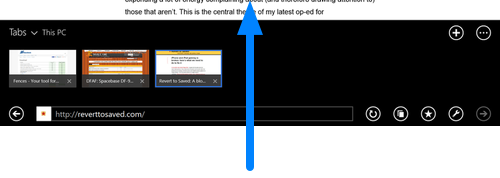
Again, the buttons are typically arranged around the edges, making them easy accessible when holding the device in landscape mode.
Hiding these UI elements by default allows the applications to use the screen for actual content. Since this gesture works the same in every application, it's an easily learnable way of accessing features. This allows the app's designer to clean up its user interface.
I've kind of glossed over it, but a few of the things I've just mentioned make the Surface quite different from an iPad.
One of them is the Share menu, which is one way in which Windows 8 apps can interact with each other. Via Contracts, apps can register themselves as sharing sources, sharing recipients, or both.11
Metro apps have access to any cloud storage app that you install (and to any other app that wants to make its "data silo" available). Fresh Paint,12 a painting app that comes with the Surface, automatically shows Dropbox and Box as file sources, once you've installed these apps.
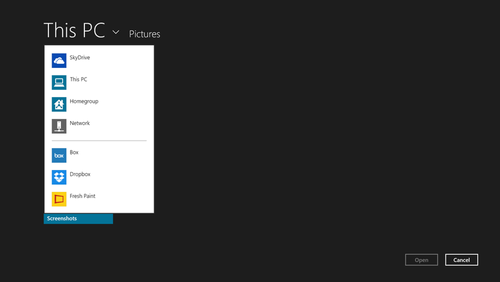
But since this is regular old Windows, that's not the only way to access files. You can access the full file system, if you want to (but you don't have to). This allows you to easily exchange files between different apps, even if they don't support the appropriate Contracts, or don't run in Metro.
Another difference between the Surface and an iPad is the Surface's split screen mode. iPad owners often note that the iPad's "one app owns the screen" system is a good idea, since people can't multitask anyway. But that ignores that people often need multiple apps to work on a single task. I can't count the instances where I've used split screen mode just in the last few days. I'm in a meeting, taking notes in OneNote while looking at last week's meeting notes. I'm responding to an email while looking at a spec. I'm making a drawing while looking at a reference. I'm changing a mockup based on feedback in an email. I'm taking notes during a Skype call.
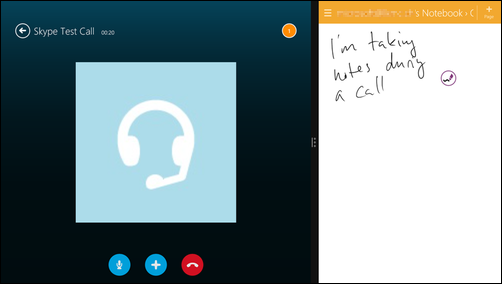
This is just an illustration of the concept. I do realize that it doesn't really make sense to take notes while looking at the test call icon. Typically, I'm looking at a presentation or a shared screen during these kinds of calls, so switching away to another app entirely is not a good solution.
When the Surface is in split-screen mode and you launch another app, it "asks" you which side of the screen to show the app.
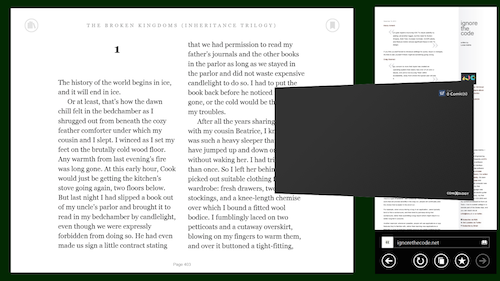
This seems slightly strange to me. I'm looking at two apps side-by-side because I want to see these specific two apps side by side, not because I want to see any two apps side-by-side. In most situations, when opening a new app, I would have preferred if the new app simply opened in full-screen mode,13 and the Surface then allowed me to jump back to the split-screen view with the previous two apps using the task switcher. That would have allowed me to easily switch between a full-screen app and two other apps in split-screen mode.
Metro's split-screen mode isn't perfect. It doesn't cover every use case. But at least for me, it covered surprisingly many of them, and it made the Surface a much better option for creative work than an iPad.
A final difference I want to mention: the Surface Pro comes with a pen. I've used the pen for annotating drafts, for sketching out user interfaces, for drawing logic diagrams, for taking notes, and for many other things.14
I've tried using the iPad for this, I really have. I've tried using my fingers. It's cumbersome. I also have a drawer full of iPad pens. I have every pen imaginable. I have pens that look like brushes, pens that look like markers, pens that have little discs on the tip, pens that create a change in capacitance using electricity, Bluetooth pens, infrared pens that require little cameras you attach to the iPad... I have all of them. I've supported ever iPad pen Kickstarter project I could find. Some of these pens are terrible, and some are acceptable, depending on what I want to use them for.
None of them are even in the same ballpark as the Surface's pen.
The Surface's pen is almost as good as my Cintiq's.15 Tracking is fast, it's pressure-sensitive, it works everywhere, and it feels like a real pen. It's great, unlike every iPad pen I've ever tried.
In general, I really love the Surface, and I use it much more, and for many more things, than I ever used any iPad I ever owned.16 But it's not perfect.
What I Find Disappointing
Windows' handwriting recognition is interesting. Technically, it performs flawlessly.17 I thought that the later Newton models had acceptable handwriting recognition, but Windows completely blows that out of the water. To give you an idea of how good it is: my handwriting is terrible,18 and I'm writing a lot of German text using the English-language handwriting recognition. Yet it works.

Unfortunately, this fantastic technology is package in an absolutely terrible user interface. First of all, handwriting recognition only works inside a handwriting recognition keyboard. Yep, you have to activate an on-screen keyboard that covers half the screen, then write inside that keyboard. Like on a Palm. Back in the 90s.
As of right now, I've not discovered how to write continuously. You have to write text until the keyboard is "full", then hit the "Insert" button. That clears the keyboard, and you can continue writing text.
The way I want handwriting recognition to work is to take notes by jotting them down inside an app like OneNote, and have Windows recognize that automatically, behind the scenes, optionally without replacing my handwritten notes with printed text. Then, I want to be able to search my handwritten notes using full-text search.19
The Newton offered a similar feature called Ink Text (PDF). It allowed you to write text directly onto the screen. Then, at a later date, you could have the Newton convert the handwritten text to printed text, either word by word, or for the whole text. Here's an example showing handwritten text, some of which has been converted.
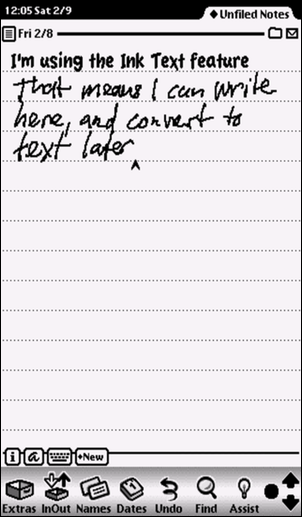
(This screenshot was taken using Einstein, which inexplicably even allows you to emulate the Newton's garish backlight.)
If the Newton could do this (and a lot more) back in the 90s, there's no reason why Windows 8 should be any worse.
One final thing I want back from the Newton is modeless error correction. When the Newton got a letter in a word wrong, you could simply overwrite it with the correct letter. On Windows, you have to enter a special correction mode, which completely does not work the way I expect it to, and always causes me to gradually make the text worse and worse when I try to fix mistakes, until I just give up, erase the whole word, and start fresh.
Presenting such beautiful technology in such a frustrating user interface is sad. But to be fair, it's not a real problem; It's just a huge missed opportunity. The actual problems only show up once tap one particular button: the "Desktop" button. Basically, you're dumped back into the old Windows user interface, and all bets are off.
What I Dislike
The regular old Windows desktop user interface was never particularly inspiring, but on a Surface, it's even worse. It barely works with touch interactions. Many of the touch targets are minuscule. Just closing a window becomes a chore.
Apps are not integrated into Metro at all. For example, I use ArtRage a lot. ArtRage is a full screen app. It would fit into Metro perfectly well. But ArtRage is not visible from within Metro. If I launch ArtRage and switch to a Metro app, ArtRage does not appear in Metro's app switcher. There's a generic "Desktop" entry in the app switcher, and this entry "contains" all running desktop apps. This isn't just cumbersome, it has an effect on utility. For example, it's not possible to use Metro's split-screen mode to see two regular Windows apps side-by-side.
Don't get me wrong, I'm glad that I can use ArtRage on my Surface. The device would be a lot less useful to me if it did not have support for "legacy" apps. But it seems to me that the integration of legacy apps into Metro should have been handled much better.
The problems with Windows 8 don't end with the integration between desktop and Metro. There's also the problem that good old Windows seems to be a pretty terrible operating system.
It's technically terrible.20 There's the problem where installing 1Password causes handwriting recognition to stop working. There's the problem where, after a few days of using the Surface, I suddenly started getting an error message about some DLL every time I restarted the Surface (which you sometimes have to do when you get updates, which you get often).21 There's the problem where games randomly don't start correctly and complain about some .net dependency. And all of this this after just a few weeks of using a factory-sealed, completely new Surface.

(The non-native resolution is the Surface's default desktop setting. Unlike a retina MacBook, the Surface screen's resolution is not high enough to get away with it.)
This is probably a good point to acknowledge that Microsoft's job is much harder than Apple's. Apple only has to support a very limited range of hardware. Microsoft has to support a potentially limitless range of hardware. Problems are bound to occur. As a user, though, I don't really care how hard Microsoft's job is. I only care whether stuff works. When my computer doesn't work right, the difficulty of Microsoft's job doesn't magically fix my problem.
The visual design is inconsistent. Windows' user interface is a mess built on top of three decades of other messes that were built on top of even earlier messes. It's turtles all the way down, except these aren't turtles. There are countless options and settings and apps scattered all over the place, and there are still situations where you only recourse is to open a command prompt and start a DOS executable.
For example, there seem to be three different ways of formatting disks (that I could find). There's diskpart, which you start from the command prompt. There's an ancient-looking application called Disk Management (which, by the way, you'll find under "System and Security", not under "Hardware and Sound", which is where I would expect it — but perhaps I'm just weird). And I think there's a popup window you get when you insert an empty, unformatted disk.
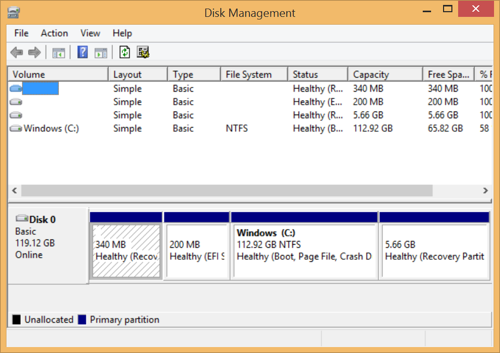
Yep, despite looking like it's coming straight out of Windows 95, this app ships with Windows 8.
It's fine to have a GUI app and a command line app, of course. As long as users are not forced to fall back to the command line tool. I'm guessing that each of these apps were added to Windows to add more convenience, but the problem is that none of them really replaced their predecessors. So they're still around, cluttering up Windows with stuff that should have been obsoleted a long time ago, forcing users to open 1981-style DOS shells on their Windows devices bought in 2014.
Why isn't there one single Metro-style disk management app that does 100% of the jobs any user will reasonably be expected to do when using a Windows PC?
The UX is erratic. Some of the apps in Windows are just bad. Go back to the Disk Management app above. I'd expect to see something like that in Linux, except that even today's better Linux distros have progressed beyond user interfaces like this.
Basic things that should really not be complicated are borderline impossible on Windows. For example, how do you create a bootable clone of your hard disk, so that you can boot from an identical external USB hard disk in case the internal disk goes belly-up? On a Mac, you just download Carbon Copy Cloner or SuperDuper22 and run it.23 In case of emergency, connect the external disk, start the Mac, hit Option, select the external disk, you're done.
On Windows? I'm still not sure. People recommended Acronis True Image for backing up Windows disks.24 Sure enough, it has a "Make this media bootable" option. Except it's greyed out. Why? Acronis says that you can only make CDs or FAT32 USB flash drives bootable. Why? I don't know.
Windows' technical limitations seem to be bubbling up into the UI, making things really hard that should be really simple. It's just a bad user experience.
The culture is terrible. At one point during the last few weeks, while working on my gaming PC, I had to copy my Windows 8 installation DVD onto a bootable USB flash drive. I googled for solutions, and lots of people recommended a specific app. So I downloaded it, and ran the installer.
"Do you want to also install some spyware?"
"No, just the app, please."
"Are you sure? It's really great!"
"No, thank you, no need."
"Click No if you want to install this browser plugin!"
Wait, uhm... "YES! Yes, I don't want it!"
"Damn, I really thought that would work. Are you sure you don't want it? It will improve your Internet search results!"
"No, please! NO! DO NOT WANT!"
"Okay! Installing Spyware now!"25
That's not an isolated example. Finding software for Windows is a nightmare. Windows users sometimes complain that Mac software is expensive. Maybe it is, but on the plus side, it generally tends to work, and typically doesn't fill your computer with adware and browser toolbars and background processes that install weird buttons in the toolbars of all of your freaking windows.
But it's not just that a lot of software comes with crummy installers. It's also that a lot of software is, itself, quite crummy. The average quality of Mac software has probably deteriorated somewhat during the last decade, as the Mac has become more popular, but it's nothing compared to what Windows users have to put up with. You could respond to that by noting that, perhaps, the average Windows app is worse than the average Mac app, but surely, the best Windows apps still beat the best Mac apps? At least in my experience, this is often not the case. The selection of Windows apps is huge, but it's not uncommon to find that all of the apps in a specific category are various levels of terrible.26
To be fair, some of these issues also exist on the Mac. Perhaps I just notice them less, because I'm more used to them. But I'm quite sure that this does not account for all of the difference I'm noticing.
Metro on a Desktop
So using the "legacy" desktop on a tablet is not a good user experience. Don't get me wrong, I'm glad it's there. I'd rather have access to it than not. I'm not complaining about the fact that I can go to the desktop, I'm complaining about the fact that Microsoft didn't do more to improve the desktop, and to integrate desktop apps into Metro.
But that's about using the desktop on a tablet. What about the reverse? What about using Metro on a desktop PC?
Large Everything
People note that designing for touch screens requires you to have much larger tap targets, because tapping is less precise than clicking — your finger is way bigger than a mouse pointer. They conclude that this creates user interfaces that are inherently bad for desktop PCs, because desktop PCs use mice.
But if you've ever seen normal people use computers, squinting at the screen to position the mouse cursor just exactly over the icon, and then carefully clicking it to make sure that they don't accidentally move the mouse while clicking and initiate a drag, you'll probably agree that desktops can really benefit from larger click targets, too. And it's not just people who are not proficient with mice. It's also people using trackballs, people working with drawing tablets, and so on.
In other words, I think the exact same design patterns that make touch screen apps work well on touch screens — large buttons, large text, uncluttered user interfaces — also make them good desktop apps.
Split Screen
A bigger issue is Metro's split screen mode. This works great on a widescreen tablet, where it seems to cover most use cases (at least in my subjective experience). On a desktop PC with a larger screen, more proficient users might want to have more power than that.27 There's also no concept of multiple desktops, which would make a lot of sense in combination with split screen windows.
I think this is a solvable problem, though. Split-screen mode is a first step in the right direction, and there's nothing preventing Microsoft from expanding on that concept for devices with larger screens.
In this context, it's interesting to note that most IDEs don't use the host operating system's window manager. Instead, they implement their own tiling window managers, which might be something Microsoft could do on the OS level.
One OS To Rule Them All
In the end, I don't think Microsoft's idea of having a single system that works on desktops and tablets is inherently flawed. I think it's a good idea. I think Metro can work well on a desktop,28 and I think it makes sense to give people on tablets the power of the Windows desktop. The Surface shows that this can work; some small tweaks to how Windows 8 handles desktop apps could already go a long way towards making this a better experience. But it's definitely true that Microsoft's execution of this idea is far from perfect.
The solution, though, should be to fix the execution, not to kill the whole idea.
The Problem with Windows 8
I have no doubt that there are people who will read what I've just written about Windows' flaws, and will write me emails, saying things like "you're so wrong! All of the things you hate are great! You just don't understand the genius that is Windows!"
I think that's the problem with Windows. There are people who enjoy tinkering with their BIOS, playing around in DOS, and installing bootloaders. And that's fine. I think it's even great. I think everybody should have the freedom to install whichever bootloader they want. The problem comes up when these people see something like Metro, do not like what they see, and then tell everybody else how terrible it is. When it's really not terrible; it's just not for them.
The things I love about Windows 8 are exactly the things that the most vocal Windows users hate, and the things I hate about Windows 8 are the things they love. So maybe the problem with Windows 8 is that Windows 8 appeals much more to me, a Mac user of 20 years, than to your typical Slashdot-commenting Ars-Technica-reading29 Windows user who frequents online forums to talk about Windows. And because these people are the most vocal Windows users, and because they tell their friends which versions of Windows to like and which to avoid, that has real effects on Microsoft's success with Windows 8.
Despite of what the most vocal Windows users say, I don't think Windows 8 is bad for your average Windows user. I think it's a step in the right direction.
Windows and Me
In the end, I really, really like Metro, but don't love Windows as a whole. It's flawed.30 But even so, I like my Surface a lot more than I ever liked any of my iPads.
When Apple introduced the iPad, they made a point of showing productivity apps. I feel like the Surface finally makes good on Apple's promise: Metro is a UI that actually works well for productivity. It's not perfect, but it's more than acceptable.
The problem with Metro might not be that it's performing badly at its intended function. The problem might simply be that, unlike me, most people don't want to use their tablets for productivity. They'd rather keep using their old Windows PC for that, and also have an iPad for watching movies and playing games.
Further Reading
Good follow-up from Shawn Blanc, who notes that it is important to discuss these topics, because we're currently in the midst of shaping what our children's computers will look like.
Anand Babu writes about different usage scenarios for Windows 8 and the Surface.
About Windows' future, Tim Anderson notes that "a revitalised desktop in Windows 9 will do little to arrest its decline."
Robert McGinley Myers points out that the iPad is better at some kinds of productivity tasks than a desktop PCs. He mentions grading papers as an example. He could not be more right; marking up PDFs is definitely much more enjoyable on a tablet with a pen than on a desktop PC with a mouse. This is exactly why I want to use a tablet for work, and why I think that Microsoft's basic idea — combining the advantages of a tablet with the advantages of a desktop PC — is fundamentally sound, and worth pursuing.
-
Probably. ↩︎
-
It's insane how futuristic Einstein running on a Galaxy Note still feels to me. Also, Columbo's Mystery Capers is still great. ↩︎
-
If this whole section of this article reads like I'm trying to apologize for the fact that the iPad doesn't work for me as a productivity device, that's because I am. The linked article, written by Matt Gemmell, concludes that "anyone trotting out that old chestnut [that the iPad isn’t a tool for productivity and creation] is either labouring under some astonishingly wrong-headed preconceptions, or is making excuses for their own failings."
Gemmell has written some great, empathetic, thoughtful pieces on usability and design (and other things). That he attributes people's inability to figure out how to use iPads for productivity to their own failings illustrates, I think, just how charged this whole topic is, and perhaps helps explain why I'm feeling the need to apologize for the fact that I haven't figured out how to use my iPad for actual work. ↩︎ -
While games also sell well on Windows, there does seem to be a visible difference. The top 100 selling and grossing iPad apps are almost exclusively games, while the Windows 8 app store shows plenty of other apps. It's difficult to compare the two platforms directly, because a lot of gamers buy Windows games from platforms like Steam. ↩︎
-
Rather than finding them in a file system, you just have to find them inside the app you used to create them. ↩︎
-
Although I kept my other, older iPad 2 that powers my iCade :-) ↩︎
-
I know it's not called that anymore, but Microsoft's replacement name is not usable as a word, and everybody knows what Metro is, so I'll continue to use Metro. ↩︎
-
There are videos out there of people using Metro for the first time, and not immediately figuring out how everything works. I still remember that the first Mac I owned came with a tutorial application that taught people how to use the mouse. Does this mean that the mouse is a bad idea? Once we get used to it, it's easy to forget how unintuitive a lot of the stuff we use really is. Sometimes it's okay to ask users to learn a few things. Indeed, Metro doesn't even require you to learn that much — much less than any Mac ever did. ↩︎
-
It's actually called "snap", but I think "split screen" is more descriptive. ↩︎
-
By the way, unlike on iOS, it's possible to change the default browser, and other default apps. ↩︎
-
Lest I anger any more Android users, I should mention that Android offers a similar feature. ↩︎
-
Please add layers to this app, Microsoft! ↩︎
-
Instead of picking one of the two sides, you can drag the app up, and it will open in full-screen mode. ↩︎
-
Yep, the fact that I love pens so much is partially related to my job, and doesn't apply to everybody. On the other hand, it's no coincidence that we use pens so much in everyday life. For any kind of task that requires even slightly precise input, from painting a still life to writing a shopping list, pens work much better than fingers. ↩︎
-
Although I'm missing some advanced stuff like tilt recognition. ↩︎
-
And I don't need to carry it in a case, because it has a built-in stand, which is pure genius. ↩︎
-
A few days after I wrote this, I installed 1Password, and handwriting recognition stopped working. Fix: kill the 1Password processes when the problem occurs. ↩︎
-
Twenty years of typing on a keyboards hasn't been kind to my handwriting. ↩︎
-
The desktop version of OneNote has a feature similar to this. Somewhat weirdly, the Metro version, the one that people actually use on tablets with pens, does not. Anyway, this should be a consistent, always available system-level feature, and not left up to individual applications. ↩︎
-
I literally spent three days installing Windows 8 on a new SSD I had put into my gaming PC. I eventually got it working by randomly changing BIOS options until I found a permutation that worked. ↩︎
-
The DLL seems to be from a Logitech driver. However, while I did at one point plug a Logitech keyboard into the Surface, I definitely did not intentionally install any Logitech drivers. It's something Windows put there by itself, only for it to become a problem later. ↩︎
-
I apologize for the oversight, Dave :-) ↩︎
-
Or use Disk Utility as a slightly less convenient, but built-in alternative. ↩︎
-
At least Windows has a pretty good uninstaller that works for almost any installed application, something the Mac still lacks. ↩︎
-
On a related note, there's still this idea that it is a good idea to have an app store with as many apps inside as possible, even if most of the apps are complete crap. On this metric, Metro is losing. However, when actually using Metro's app store, I think that, just like iOS and Android, it has stepped over that threshold where there are so many apps that it becomes impossible to use the store for discovering new apps. So... bully for Microsoft? I'm still waiting for an app store that prides itself on selecting for quality, rather than quantity (which isn't possible on the iPhone, because apps can't be sold outside of the App Store, so Apple has to be as inclusive as possible — but it would be possible for Microsoft, were it not for this inane idea that more always means better when it comes to app stores). ↩︎
-
I initially wrote that you can only see two windows side-by-side when running Metro on larger screens. This is false. Depending on your screen size, you can see three or more windows side-by-side. ↩︎
-
Just replacing the messy, crowded Start menu with Metro's home screen is already a huge improvement. If you want to launch an application, why not use the whole screen to provide a good UI, rather than a tiny part of the screen to provide a terrible UI? All of the arguments I've seen in favor of bringing back the old Start menu seem to boil down to change aversion. ↩︎
-
See the comments on this article for an example. ↩︎
-
Before I forget it, here's another flaw: Windows 8's calendar app doesn't support Google Calendar. ↩︎
If you require a short url to link to this article, please use http://ignco.de/570




